Introduction
Probiotic is a quite new term which means “for life” and FAO/WHO [1] defines probiotic bacteria as “living microorganisms which when administered in adequate amounts confer a health benefit on the host”. The consumption on a daily basis of food containing viable probiotic bacteria improves human health and longevity [1]. Nowadays, there is a growing demand for healthier products, thus manufacturers are continuously exploring the development of new probiotic products with high added value, to lure health conscious consumers [2, 3]. Additionally, in order of a product to provide a therapeutic effect, it should contain 106-108 per ml or g viable cells [4, 5].
Some of the known probiotics for commercial use in the dairy industry belong to members of the genera Bifidobacterium, Lactobacillus, Streptococcus and Enterococcus [6]. Lately, much work is being done to isolate new probiotic strains from fermented food products and subsequently use them to produce novel ones with high added value [7-9]. Numerous strains of the genus Lactobacillus have been already isolated from fermented food products, characterized as safe and much attention is given on their probiotic potential as adjunct cultures in dairy foods [10-14]. Consequently, Lactobacillus species like Lb. casei, Lb. paracasei and Lb. plantarum which have been isolated from various cheeses as part of the non starter lactic acid bacteria microflora (NSLAB) and characterized as probiotics, play a major role in the dairy industry in the fermentation of several products [10, 13, 14-16]. However, it’s of great importance to mention that there is no universal strain that would provide all the suggested benefits but the biological effects are strain specific [16]. Nevertheless, aside the health promoting effects of these products, the overall properties, including sensory profile and the expanded variety of products that can be produced with the addition of probiotic strains influence the purchasing decisions of consumers [17-18].
The risk of cheese contamination with food-borne pathogens at processing level can take place at various stages at the food processing environment and a variety of possible sources involve starter cultures, brine, packaging material, cheese tank or cheese cloth, cutting equipment, floors and ripening rooms [19]. Latest studies performed in Europe on retail foods indicated the occurrence of Listeria spp. and Listeria monocytogenes in various cheese types [20-22]. One other study dealing with different scenarios of contamination with the pathogen on food processing facilities revealed that L. monocytogenes is a common colonizer in food processing environments and the risk for cross contamination is consistent and always possible at both farm-house based or large food producing facilities [23]. Recorded outbreaks by European Food Safety Authority for year 2013 [24] included cheeses as causative agents of food-borne diseases and reported that human listeriosis increased in EU during the period 2009-2013, while among of the reported cases on RTE foods at retail were soft, semi-soft and hard cheeses. Finally, L. monocytogenes as a ubiquitous pathogen it is recognized as a post-processing contaminant in dairy products [25].
Based on the above, the aim of the current study was to evaluate the performance of a Lb. plantarum strain with probiotic potential as adjunct culture in a fresh cheese manufacture and its ability to give final products with pleasing sensory characteristics and extend shelf life/ensure safety by suppressing the growth of spoilage/pathogenic bacteria. Lb. plantarum T571 strain has been isolated from traditional Greek cheese and its probiotic potential has been previously explored in vitro [9]. Fresh cheese was manufacture with or without the probiotic strain and stored at 4°C under vacuum packaging for a total shelf life period of approximately 42 days and microbial, physicochemical, molecular and sensory analysis were performed. PFGE was used to monitor i) the survival of the probiotic strain Lb. plantarum T571 at appropriate levels (>106 log CFU/g) on cheese, to confer such product as probiotic and ii) the survival and the variability of the 3 strains of the pathogen during shelf life at cold storage.
Materials and Methods
Microbial cultures
The probiotic strain Lb. plantarum T571 has been isolated from brine of Feta cheese and its probiotic ability was recently examined in vitro [9]. The strain was grown at 30°C for 18-24h on MRS Broth. For cheese inoculation, overnight culture was centrifuged at 10.000 g for 5 min, washed twice with ¼ strength Ringer’s solution, resuspended in Ringer solution in order to give the desired number of cells (105 CFU/g) for inoculation of probiotic fresh cheese.
3 strains of Listeria monocytogenes were used as cocktail to inoculate fresh cheese. The 3 selected strains originated from Greek industries and were kindly provided by Agricultural University of Athens. In more details, FMCC-B-129 was isolated from ready-to-eat frozen meal- mince meat based, FMCC-B-131 was isolated from conveyor belt of ready-to-eat frozen food and FMCC-B-133 was isolated from soft cheese. The strains were grown at 37°C for 18-24h on BHI Broth, centrifuged at 10.000 g for 5 min and washed twice with ¼ strength Ringer’s solution, resuspended in Ringer solution in order to give the desired number of cells (ca 103 CFU/g) for inoculation of cheese to both control and probiotic cases.
Production of fresh cheese
Fresh cheese samples were produced at the laboratory of Institute of Technology of Agricultural Products, HAO-DEMETER. In brief, raw ewe and goat milk were purchased and then pasteurized at 68°C for 10min. Citric acid was added to the milk in order to coagulate and the coagulants were collected at a cheese cloth. When the temperature of the curd was approximately 35°C, the curd was inoculated with the probiotic strain Lb. plantarum T571. Samples with (probiotic sample) or without (control samples) free cells of Lb. plantarum T571 were also inoculated with approximately 3 log CFU/g initial inoculum level of L. monocytogenes (cocktail of 3 strains). Draining of the cheese at 18°C for 18h followed and finally, cheese was vacuum packed and stored at cold storage (4°) for 42 days of shelf life.
All experiments were carried out in triplicate. Samples from each treatment were collected at various times intervals and subjected to physicochemical, microbiological and molecular analysis, as well as to sensory evaluation.
pH determination
During production and storage, pH measurements were carried out using a pH-meter (pH-330i pH meter, WTW GmbH, Weilheim, Germany) after the end of the microbiological analysis.
Titratable acidity
Titratable acidity was measured by titrating 9g of sample with 0.1N NaOH solution using phenolphthalein as the indicator.
Water activity
Water activity was measured using Aqualab Lite water activity meter (Dacegon Devices Inc, Pullman WA, USA). 5gr of cheese sample were placed in the cup and measured in triplicates. Calibration of the device was made using bi-distilled water.
Microbial Enumeration
Microbiological analysis took place during cheese manufacture (curd) and until the end of the shelf life of the product stored at 4°C. To estimate the number of viable cells, cheese samples (25 g) were weighed aseptically, added to sterile ¼ strength Ringer’s solution and homogenized in a stomacher (Stomacher 400 circulator, Seward Limited, Norfolk, UK) for 60 s at room temperature. Serial dilutions were prepared with the Ringer solution and duplicate 0.1 or 1 ml samples of the appropriate dilutions were spread or mixed on the following media: Plate Count Agar (PCA, 4021452, Biolife, Milano, Italy) for total viable counts, incubated at 30°C for 48-72 h; Pseudomonas Agar Base with selective supplement (PAB, 401961, Biolife, Milano, Italy) for Pseudomonas spp., incubated at 25°C for 48-72 h; Streptomycin Thallous Acetate-Actidione Agar (STAA, 402079, Biolife, Milano, Italy) for the enumeration of Brochothrix thermosphacta, incubated at 25°C for 72 h; Rose Bengal Chloramphenicol Agar (RBC Agar, BK151HA, Biokar diagnostics, Allonne, France) for yeasts and molds incubated at 25°C for 72 h; Baird Parker Agar (BP, LABM, Lancashire, United Kingdom) with Egg Yolk Tellurite (X085, LABM, Lancashire, United Kingdom) for coagulase-positive staphylococci incubated at 37°C for 48 h; Tryptone Bile X-glucuronide medium (TBX, CM0945, OXOID, Basingstoke, United Kingdom) for the detection and enumeration of Escherichia coli incubated first for 4 h at 30°C, then for 18-24 h at 44°C; Palcam Agar (Palcam Agar, BK145HA, Biokar Diagnostics, Allonne, France) with Palcam selective supplement (BS00408, Biokar Diagnostics, Allonne, France) for the enumeration of Listeria monocytogenes incubated at 37°C for 24 and 48 h; Violet Red Bile Glucose Agar (VRBGA, 402185, Biolife, Milano, Italy) for Enterobacteriaceae counts, overlaid with the same medium and incubated at 37°C for 18-24 h; de Man-Rogosa-Sharp medium (MRS, 4017282, Biolife, Milano, Italy) for lactic acid bacteria, overlaid with the same medium and incubated at 30°C for 48-72 h. When pathogen levels were below detection limit of the enumeration methods, enrichment was followed to ensure the presence/absence of the pathogen according to ISO 11290-1:1996/Amnd1:2004 for Listeria monocytogenes.
Isolation and growth of lactic acid bacteria cells and Listeria cells
Colonies of lactic acid bacteria and colonies of the pathogen were isolated during sampling of cheese, in order to ensure the survival of the probiotic Lb. plantarum T571 and to check the differentiation on Listeria strains during storage at cold storage. In brief, cheese was sampled at appropriate time intervals and from different time points (beginning, middle and end point of shelf life) approximately 30 colonies from lab were collected randomly from the 6th dilution in MRS Agar whilst Listeria cells were collected each time from the appropriate dilution (30-300 colonies) of Palcam Agar. Pure cultures included in this study, were stored at −80°C in MRS Broth or BHI Broth supplemented with 20% (v/v) glycerol (Penta, Radiova, Praha). Before further analysis, each isolate was grown twice in MRS broth for lactic acid bacteria at 30°C for 24 h and BHI broth for Listeria strains at 30°C for 24 h and purity of the culture was always checked in MRS agar plates before use.
Pulsed-Field Gel Electrophoresis (PFGE)
PGFE for the identification of Lb. plantarum T571 was performed according to Doulgeraki et al. [26] while identification for L. monocytogenes was performed according to Papadopoulou et al. [27].
In brief, isolates were digested with the restriction enzyme ApaI (10 U) (New England Biolabs, Ipswich, MA, USA). ApaI was used according to the manufacturer’s recommendations for 16 h. Restriction fragments were separated in 1% PFGE grade agarose gel (Bio-Rad, Hercules, CA, USA) in 0.5 mM Tris-Borate buffer on CHEF-DRIII (Bio-Rad, Hercules, CA, USA) equipment with the following running parameters: For lab fragments the program used was 6 V cm-1, 1 sec initial switching time, 10 sec final switching time and 16 h of a total run at 14°C. For Listeria fragments the appropriate parameters were 6 V cm-1, 4 sec initial switching time, 40 sec final switching time and 18 h of a total run at 14°C. Gels were then stained with ethidium bromide (0.5 mg ml-1) in water for 1 h and destained for 2 h before being photographed using a GelDoc system (Bio-Rad, Hercules, CA, USA). Conversion, normalization and further analysis were performed using the Pearson coefficient and UPGMA cluster analysis with Bionumerics software, version 6.1 (Applied Maths, Sint-Martens-Latem, Belgium).
Sensory evaluation
For quantification of the descriptive attributes of the cheese samples, quantitative descriptive analysis was performed (QDA). QDA is a technique which is traditionally used for the evaluation of dairy products [28]. Before sensory analysis, 15 people (personnel from the Institute of Technology of Agricultural Products of Hellenic Agricultural Organization-DEMETER) were trained and tested in order to assess the perception of saltiness, sweetness, acidity and bitterness. For this reason, different concentration solutions of sodium chloride (0.1, 0.5 and 1.5%), sucrose (1, 4 and 8%), lactic acid (0.1, 0.8 and 1.0%) and quinine (0.01, 0.05 and 0.1 mM), were evaluated by the panel. Three sessions of 2 hours each were made in where the evaluators had to exhibit an accuracy of at least 75% on the perception of the examined solutions in order to be chosen for the sensory evaluation of the cheese samples. Finally, 10 assessors formed the trained team, 5 men and 5 women aged between 25 and 55 years old. Data were obtained through a non-structured evaluation sheet containing the attributes in a 10-cm intensity scale [29]. Direction of the hedonic scale was from left to right with increasing intensities, e.g., weak to strong, little to much. For the sensory evaluation, overall conception of appearance, aroma, taste and texture of the control and probiotic products were assessed from the panel as well as for each sensorial characteristic. Identification of specific indicators i.e white color, holes or cracks on cheese, acidic, buttery or animal aroma, acidic, sweet, salty, bitter or rancid taste, consistency, hardness and grainy texture were estimated. An abnormal appearance, unusual texture, taste, or aroma was considered unacceptable. Sensory evaluation was conducted in triplicate using locally approved protocols in artificial light in individual booths [30]. The same trained persons were used in all evaluations and all were unaware of the tested sample. Cheeses were served in plastic dishes codified with 3 digits. Panelists used unsalted crackers and water to clean their palates between samples.
Statistical Analysis
All experiments were carried out in triplicate (3 independent batches of cheese were prepared). Significance was established at P<0.05. Results were analyzed for statistical significance with analysis of variance (ANOVA). Duncan’s multiple range test was used to determine significant differences among results [coefficients, ANOVA tables and significance (P<0.05) were computed using Statistica v.5.0]. Non parametric Kruscal Wallis test was performed for sensory analysis data.
Results and Discussion
Microbial population
A variety of traditional and industrialized fresh cheese products are produced worldwide with differentiation on manufacturing process, i.e. the use or not of starter cultures, the addition or not of rennet or acid for coagulation of milk [31-33].
Lb. plantarum T571 was employed as adjunct culture in fresh cheese production and microbiological analysis was performed during storage at cold temperature. Microbial populations for control and probiotic samples are presented at Figures 1 and 2, respectively. For the probiotic case of fresh cheese, lactobacilli counts remain stable (ca 8 log CFU/g) during shelf life of the products at cold storage, while for the control case, lactobacilli increased during first days of storage up to 6.1 log CFU/g. Counts of Enterobacteriaceae were detected in the current study for both cases. In more details, at probiotic cheese, their population was lower and decreased during shelf life, whereas at control case the population was found much higher (ca 5 log CFU/g) during storage. Finally, Pseudomonas spp. were present for both cases and slightly increased for probiotic samples whilst for control sample increased approximately 3 logs until the end of shelf life at 4°C. No yeasts/molds, Brochothrix thermosphacta, coagulase positive staphylococci or Escherichia coli were detected at the current study. It should also be noted, that the non inoculated cheese samples remained Listeria free throughout manufacture and storage at 4°C for both probiotic and control cases.
Many studies dealing with the microbial quality of fresh cheeses with high pH reported that coliforms, Pseudomonas spp. and yeasts/moulds are usually present in high numbers and occasionally pathogens i.e. Listeria spp. or Staph. aureus are detected [19-20, 22 ]. Cheeses are ready-to-eat foods which generally do not undergo any further treatment prior to consumption and it is of great importance for the final product to have high level of hygiene, because the high pH, low salt and high water activity support high population level of microorganisms. The addition of lactic acid bacteria as biopreservative agents to control spoilage of fresh cheese may help in the extension of shelf life of products. Several studies have already incorporate NSLAB in bread, feed, fruits, vegetables or dairy products in order to extend shelf life of the aforementioned products [34].
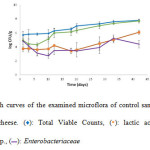 |
Figure 1: Growth curves of the examined microflora of control samples during shelf life of fresh cheese. (♦): Total Viable Counts, (▪): lactic acid bacteria, (●): Pseudomonas spp., (▬): Enterobacteriaceae Click here to View figure |
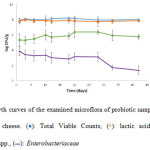 |
Figure 2: Growth curves of the examined microflora of probiotic samples during shelf life of fresh cheese. (♦): Total Viable Counts, (▪): lactic acid bacteria, (●): Pseudomonas spp., (▬): Enterobacteriaceae Click here to View figure |
Main characteristics of fresh cheeses are the short shelf life and the sensitivity of colonization by L. monocytogenes through post processing contamination [35]. For this reason, the cheese samples were also inoculated with a cocktail of 3 strains of Listeria monocytogenes during storage with initial inoculum level of approximately 3 log CFU/g. From the results it was evident that, at control samples pathogen population increased during shelf life and the final population maintained above 7.5 log CFU/g. In more details, population of the pathogen during 1st day of shelf life was found 5.3 log CFU/g. On the other hand, pathogen population during first day of storage at probiotic cheese was approximately 2 logs lower (3.4 log CFU/g). However, L. monocytogenes increased at probiotic case during shelf life and reached final population of 7 log CFU/g. High water activity (Fig. 5) and pH (Fig. 3) allow the growth of the pathogen during cold storage as it was evident from this study.
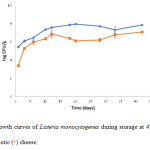 |
Figure 3: Growth curves of Listeria monocytogenes during storage at 4°C for control (♦) and probiotic (▪) cheese. Click here to View figure |
Physicochemical Characteristics
All physicochemical parameters e.g. pH (Fig. 3), titratable acidity (Fig. 4) and water activity- aw (Fig. 5) were found at usual levels. pH and titratable acidity were significantly (P<0.05) affected by probiotic culture. Figure 3 demonstrated the changes in the pH during shelf life of control and probiotic cheese. From the results it was evident that, the probiotic culture was poor acidifier since the pH value of the milk was 6.7 and reduced to 6.51 for probiotic cheese at the 1st day of storage, whereas control cheese had pH value 6.63. It was noticeable that probiotic cheese had lower pH value due to the added lactic culture. The increase in titratable acidity was more intense for cheese samples manufactured with cells of the probiotic strain T571 as it can be seen in Figure 4. These results are in accordance with previous works where the probiotic cultures used showed poor acidification [35]. Finally, water activity had similar values for both cases examined (0.98) and was close to unity. This value is optimal for growth of most microorganisms.
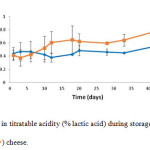 |
Figure 4: Changes in titratable acidity (% lactic acid) during storage at 4°C for control (♦) and probiotic (▪) cheese. Click here to View figure |
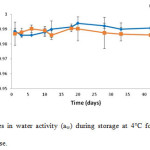 |
Figure 5: Changes in water activity (aw) during storage at 4°C for control (♦) and probiotic (▪) cheese. Click here to View figure |
Monitoring Lb. plantarum T571 survival
To confer a product as probiotic is required a minimum number of living probiotic cells in the food product of approximately 6 log CFU per g or ml [4, 5]. Therefore, aim of the study was to investigate whether or not Lb. plantarum T571 was present at cheese samples above this threshold level during shelf life at cold storage. Mesophillic lactobacilli counts in probiotic cheese samples during storage at 4°C are presented in Figure 2. Numbers of mesophillic lactobacilli remained at high levels during storage at 4°C for probiotic cheese. A total of 100 isolates were isolated from cold temperature from petri dishes that correspond to the 6th dilution for initial (day 1), middle (day 18) and final (day 42) storage time. The presence of Lb. plantarum T571 at all cases was confirmed by PFGE. The results demonstrated that up to 100% of the microorganisms recovered belonged to Lb. plantarum T571 during shelf life at 4°C (Fig. 6). Lb. plantarum T571 was detected in probiotic cheeses at levels required for conferring a probiotic effect (≥ 6 log CFU/g) throughout storage at 4°C.
PFGE, a DNA- based technique can discriminate microorganisms up to strain level [26]. The use of molecular techniques to monitor the added probiotic strains and certify their vitality during shelf life of the products is already employed by many researchers. Many studies used molecular methods to discriminate the lab strains to identify the probiotic strains among other lab strains and to strengthen the hypothesis of conferring a product as probiotic [36-38].
Table 1: Distribution of isolates of Lb. plantarum T571 recovered during shelf life of fresh cheese samples based on to the PFGE profiles at 4 °C.
|
Temperature |
strains |
inoculant |
shelf life – Day 1st |
shelf life – Day 18th |
shelf life – Day 42nd |
|
4°C |
Lb. plantarum T571 |
100% |
100% |
100% |
100% |
|
other LAB |
nd* |
nd |
nd |
nd |
Not detected
Monitoring pathogen survival and strain differentiation
Listeria monocytogenes is a post processing contaminant on dairy products and many studies have been conducted until today, investigating the presence of the pathogen on retail products in Europe [20-22]. Recent studies demonstrated that Listeria survival is strain depended when was tested on real food ecosystem [36, 39]. For that reason fresh cheese was inoculated with a 3 cocktail strain of the pathogen and the survival and differentiation of the strains during shelf life was monitoring with molecular methods throughout storage for control and probiotic cheese. Design of the experiment was such to have the same initial levels of the three strains in the cocktail inoculants as it is presented in Figure 7. Population of inoculated strains increased during cheese production and continued to increase during storage, as it has been already described above. Long term survival of Listeria monocytogenes was observed at probiotic samples at 4°C regardless for the high population (>7 log CFU/g) of lactic acid bacteria until the end of storage. Finally, 120 isolates recovered from the appropriate materials and subsequently were screened with PFGE. Figure 7 represent distribution of isolates of Listeria monocytogenes strains recovered during production and shelf life of control and probiotic cheese samples with the addition of Lb. plantarum T571 based on to the PFGE profiles. In more details, interesting remarks were made about strain occurrence at control and probiotic samples. At probiotic cheese samples, strain B129 was found at the highest level at the end of shelf life while during storage strain occurrence varied starting from 33.33% to 86.67% at middle shelf life. At control samples, strain B129 was also the strain with the highest presence. B131 strain was the most susceptible strain for control case whereas strain B133 was found to be the most susceptible for probiotic case (Fig. 6). In conclusion, the 3 strains reacted differently in terms of occurrence at control and probiotic cases as it is presented in Figure 7.
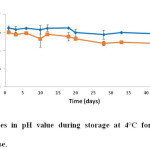 |
Figure 6: Changes in pH value during storage at 4°C for control (♦) and probiotic (▪) cheese. Click here to View figure |
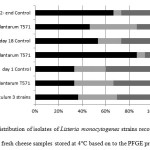 |
Figure 7: Distribution of isolates of Listeria monocytogenes strains recovered during shelf life of fresh cheese samples stored at 4°C based on to the PFGE profiles. Click here to View figure |
Sensory Evaluation
The results of the sensory evaluation of fresh cheese are graphically presented as “spider webs” in Figure 8. Results represented sampling days 1st, 18th, and 42nd at cold storage. In more details, the sensory panel evaluated the new probiotic cheese better than the control one for total taste and appearance, during shelf life at 4°C (Fig. 8). Overall, the supplementation of cheese with free cell culture of Lb. plantarum T571 provided higher scoring (P<0.05) in contrast to control for total evaluation until the end of shelf life. In details, total taste and total aroma were found significant different (P<0.05), however total texture and total appearance were not differed significantly (P>0.05). Taste panel considered the probiotic fresh cheese to be more acidic (P<0.05) compared to the control sample but the sweet taste was similar (P>0.05). Concerning bitterness and rancidity, probiotic cheeses received similar values with the control ones (P>0.05). In addition, total texture scores for probiotic products were similar with those of controls (P>0.05).
Consumer’s acceptance of new products is of paramount importance for the food industry. The selected strains should preserve traditional taste and aroma, maintaining the quality. Based on the above, probiotic Lb. plantarum T571 could be successfully used as adjunct culture for fresh cheese production and also provide functional properties at the final product.
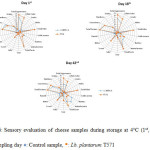 |
Figure 8: Sensory evaluation of cheese samples during storage at 4°C (1st, 18th, and 42nd sampling day ♦: Control sample, ▪: Lb. plantarum T571 Click here to View figure |
Acknowledgments
The present research program was financially supported by the Action ‘Elaboration of Research & Technology Development Innovation projects’- AgroETAK, MIS453350, in the frames of the Operational Program ‘Human Resources Development’, under the thematic priority axis 2 ‘Reinforcement of adaptability, Human Resources and Enterprises’ and has been co-financed by the EU-ESF in the framework of NSRF 2007-2013.
References
- FAO/WHO. Probiotics in food. Health and nutritional properties and guidelines for evaluation. In FAO Food and nutrition paper 85, Roma (2006)
- Zamfir M. Vancanneyt M., Makras L., Vaningelgem, F., Lefebvre K., Pot B., Swings, J. and De Vuyst, L. Biodiversity of lactic acid bacteria in Romanian dairy products. Systematic and Applied Microbiology, 29: 487-495: (2006)
CrossRef - Gueimonde M., Delgado S., Mayo B., Ruas-Madiedo P., Margolles A. and de los Reyes-Gavilan C.G. Viability and diversity of probiotic Lactobacillus and Bifidobacterium populations included in commercial fermented milks. Food Research International, 37: 839-850: (2004)
CrossRef - Raeisi S. N., Ouoba L. I. I., Farahmand N., Sutherland J. and Ghoddusi H. B. Variation, variability and validity of bifidobacteria in fermented milk products. Food Control, 34: 691-697: (2013)
CrossRef - Patrignani F., Burns, P. Serrazanetti D., Vinderola G., Reinheimer J., Lanciotti R. and Guerzoni M.E. Suitability of high pressure-homogenized milk for the production of probiotic fermented milk containing Lactobacillus paracasei and Lactobacillus acidophilus. Journal of Dairy Research, 76: 74-82; (2009)
CrossRef - Salminen S, von Wright A, Morelli L, Marteau P, Brassart D, et al. Demonstration of safety of probiotics – A review. International Journal of Food Microbiology, 44: 93-106: (1998)
CrossRef - Argyri A. A., Zoumpopoulou G., Karatzas K. A. G. , Tsakalidou E. , Nychas G. J. E. Selection of potential probiotic lactic acid bacteria from fermented olives by in vitro tests. Food Microbiology, 33: 282-291: (2013)
CrossRef - Botta C., Langerholc T., Cencič A., Cocolin L. In Vitro Selection and Characterization of New Probiotic Candidates from Table Olive Microbiota. PLoS ONE, 9:e94457: (2014)
CrossRef - Pavli F., Argyri A., Papadopoulou S. O., Nychas G. J., Chorianopoulos N. and Tassou C. C. Selection and characterization of potential probiotic lactic acid bacteria from traditionally fermented dairy and meat products by in vitro tests. Journal of Probiotics and Health, submitted for publication: (2016)
- Burns P., Cuffia F., Milesi M., Vinderola G., Meinardi C., Sabbag N. and Hynes E. Technological and probiotic role of adjunct cultures of non-starter lactobacilli in soft cheeses. Food Microbiology, 30: 45-50: (2012)
CrossRef - Dimitrellou D., Kandylis P., Sidira M., Koutinas A. A., and Kourkoutas Y. Free and immobilized Lactobacillus casei ATCC 393 on whey protein as starter cultures for probiotic Feta-type cheese production. Journal of Dairy Science, 97: 4675-4685: (2014)
CrossRef - Kotzamanidis C., Kourelis A., Litopoulou E., Tzanetakis N. and Yiangou M. Evaluation of adhesion capacity, cell surface traits and immunomodulatory activity of presumptive probiotic Lactobacillus strains. International Journal of Food Microbiology, 140: 154-163: (2010)
CrossRef - Maragkoudakis P. A. , Zoumpopoulou G., Miaris C., Kalantzopoulos G., Pot B. Probiotic potential of Lactobacillus strains isolated from dairy products. International Dairy Journal, 16: 189-199: (2006)
CrossRef - Zago M., Fornasari M. E. Carminati D., Burns P., Suàrez V., Vinderola G., Reinheimer J. and Giraffa G. Characterization and probiotic potential of Lactobacillus plantarum strains isolated from cheeses. Food Microbiology, 28: 1033-1040: (2011)
CrossRef - Milesi M. M., McSweeney P. L. H. and Hyne E.R. Viability and contribution to proteolysis of an adjunct culture of Lactobacillus plantarum in two model cheese systems: Cheddar cheese-type and soft-cheese type. Journal of Appied Microbiology, 105: 884-892: (2008)
CrossRef - Vasiljevic T. and Shah N. P. Probiotics-From Metchnikoff to bioactives. International Dairy Journal, 18: 714-728: (2008)
CrossRef - Vinderola, C. G., Bailo N. and Reinheimer J. A. Survival of probiotic microflora in Argentinian yogurts during refrigerated storage. Food Research International, 33 : 97-102: (2000)
CrossRef - Mufandaedza J., Viljoen B. C., Feresu S. B. and Gadaga T. H. Antimicrobial properties of lactic acid bacteria and yeast – LAB cultures isolated from traditional fermented milk against pathogenic Escherichia coli and Salmonella enteritidis strains. International Journal of Food Microbiology, 108: 147-152: (2006)
CrossRef - Kousta M., Mataragas M., Skandamis P. and Drosinos H.E. Prevalence and sources of cheese contamination with pathogens at farm and processing levels. A review. Food Control, 21: 805-815: (2010)
CrossRef - Filiousis G., Johansson A., Frey J. and Perreten V. Prevalence, genetic diversity and antimicrobial susceptibility of Listeria monocytogenes isolated from open-air food markets in Greece. Short Communication. Food Control, 20: 314-317: (2009)
CrossRef - Little C. L., Rhoades J. R., Sagoo S. K., Harris J., Greenwood M., Mithani V., Grant K. and McLauchlin J. Microbiological quality of retail cheeses made from raw, thermized or pasteurized milk in the UK. Food Microbiology, 25: 304-312: (2008)
CrossRef - Panagou E. Z., Nychas G. J. E. and Sofos J. N. Types of traditional Greek foods and their safety. A review. Food Control, 29: 32-41: (2013)
CrossRef - Muhterem-Uyar M., Dalmasso M., Bolocan A. S., Hernandez M., Kapetanakou A. E., Kuchta T., Manios S. G., Melero B., Minarovicova J., Nicolau A. I., Rovira J., Skandamis P. N., Jordan K., Rodríguez-Lazaro D. R., Stessl B. and Wagner M. Environmental sampling for Listeria monocytogenes food control in food processing facilities reveals three contamination scenarios. Food Control, 51: 94-107: (2015)
CrossRef - EFSA, European Food Safety Authority. The European Union summary report on trends and sources of zoonoses, zoonotic agents and food-borne outbreaks in 2013. EFSA Journal, 13: 3991: (2015)
- Tirloni E., Bernardi C., Colombo F. and Stella S. Microbiological shelf life at different temperatures and fate of Listeria monocytogenes and Escherichia coli inoculated in unflavored and strawberry yogurts. Journal of Dairy Science, 98: 4318-4327: (2011)
CrossRef - Doulgeraki A. I., Paramithiotis S., Kagkli D. F., Nychas G. J. E. Lactic acid bacteria population dynamics during minced beef storage under aerobic or modified atmosphere packaging conditions. Food Microbiology, 27: 1028-1034: (2010)
CrossRef - Papadopoulou O., Doulgeraki A. I., Cocolin L., Botta C. and Nychas G. J. E. Genotypic characterization of Brochothrix thermosphacta isolated during storage of minced pork under aerobic or modified atmosphere packaging conditions. Meat Science, 92: 735-738: (2013)
CrossRef - Gaze L. V., Oliveira B. R., Ferrao L. L., Granato D., Cavalcanti R. N., Conte Júnior C. A. and Freitas M. Q. Preference mapping of dulce de leche commercialized in Brazilian markets. J ournal of Dairy Science, 98: 1443–1454: (2015)
CrossRef - Cruz A. G., Cadena R. S., Castro W. F., Esmerino E. A., Rodrigues J. B., Gaze L., Faria J. A. F., Freitas M. Q., Deliza R. and Bolini H. M. A. Consumer perception of probiotic yogurt: Performance of check all that apply (CATA), projective mapping, sorting and intensity scale. Food Research International, 54: 601-610: (2013)
CrossRef - Moussaoui K. A. and Varela P. Exploring consumer product profiling techniques and their linkage to a quantitative descriptive analysis. Food Quality Preference, 21: 1088-1099: (2010)
CrossRef - Faccia M., Trani A., Gambacorta G., Loizo P., Cassone A., Capponio F., Production technology and characterization of Fior di latte cheeses made from sheep and goat milks. Journal of Dairy Science, 98 (3): 1402-1410: (2015)
CrossRef - Jimenez- Maroto L. A., Lopez- Hernandez D. L., Borneman, D. L., Rankin S., A. A comparison of fresh, pasta filata, and aged Hispanic cheeses using sensory, chemical, functional, and microbiological assessments. Journal of Dairy Science, 99: 2680-2693: (2016)
CrossRef - Masotti F., Battelli .G, De Noni I. The evolution of chemical and microbiological properties of fresh goat milk cheese during its shelf life. Journal of Dairy Science, 95: 4760-4767: (2012)
CrossRef - Sedaghat H., Eskandari M. H. Moosavi- Nasab M., Shekarforoush S. S. Application of non-starter lactic acid bacteria as biopreservative agents to control fungal spoilage of fresh cheese. International Dairy Journal, 56:87-91: (2016)
CrossRef - Coehlo M. C., Silva, C. C. G., Ribeiro, S. C., Dapkevicius, M. L. N. E., Rosa, H. J. D. Control of Listeria monocytogenes in fresh cheese using protective lactic acid bacteria. International Journal of Food Microbiology, 191: 53- 59: (2014)
CrossRef - Papadopoulou S. O., Argyri A., Varzakis E., Sidira M., Kourkoutas Y., Tassou C. C. and Chorianopoulos N. Selection Greek functional Feta cheese: enhancing quality and safety using a Lactobacillus plantarum strain with probiotic activity. Journal of Applied Microbiology, submitted for publication: (2016)
- Saxami G., Papadopoulou O. S., Chorianopoulos N., Kourkoutas, Y., Tassou, C.C. and Galanis A. Molecular detection of two potential probiotic lactobacilli strains and evaluation of their performance as starter adjuncts in yogurt production. International Journal of Molecular Science, 17: 668: (2016)
CrossRef - Sidira M., Santarmaki V., Kiourtzidis M., Argyri A. A, Papadopoulou O. S, Chorianopoulos N., Tassou C., Kaloutsas S., Galanis A. and Kourkoutas Y. (2016) Evaluation of immobilized Lactobacillus plantarum 2035 on whey protein as adjunct probiotic culture in yoghurt production. LWT – Food Science and Technology, 75: 137-146: (2017)
- Kagli D. M., Iliopoulos V., Stergiou V., Lazaridou A. and Nychas G. J. Differential Listeria monocytogenes Strain Survival and Growth in Katiki, a Traditional Greek Soft Cheese, at Different Storage Temperatures. Applied Enviromental Microbiology, 75: 3621-3626: (2009)
CrossRef

This work is licensed under a Creative Commons Attribution 4.0 International License.




